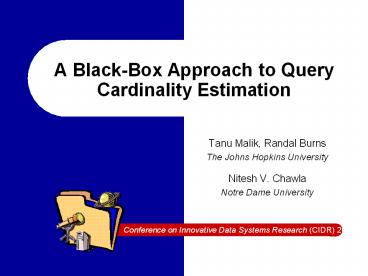A Black-Box Approach to Query Cardinality Estimation - PowerPoint PPT Presentation
Title:
A Black-Box Approach to Query Cardinality Estimation
Description:
Does not build a model. The Black Box approach. Data independent in both inputs and estimation ... Compact models, summary data structures ... – PowerPoint PPT presentation
Number of Views:79
Avg rating:3.0/5.0
Title: A Black-Box Approach to Query Cardinality Estimation
1
A Black-Box Approach to Query Cardinality
Estimation
- Tanu Malik, Randal Burns
- The Johns Hopkins University
- Nitesh V. Chawla
- Notre Dame University
2
The Black Box Approach
- Estimate query result sizes without knowledge of
- Underlying data distributions
- Query execution plan
- Machine learning techniques
- Group queries into syntactic families (templates)
- Learn in a high-dimension, complex input space
- Attributes, operators, function arguments,
aggregates - Partition input space
- Learn regression functions in each partition
- Self-tuning, self-correcting models
- When compared with bottom-up estimation
- Produces accurate, highly compact, and fast
models - Lose ability to evaluate sub-plans
3
Are new techniques needed?
- Working with federated and remote data sources
- No access to data (privacy and performance
concerns) - Many data sources (cant keep estimates for all)
- Our motivation caching in federations
- Ask the DB optimizer?
- Other applications
- Replica maintenance
- Grid workflow
- Distributed query schedulers
4
Astronomy Example
- Typical query
- User-defined functions
- Mathematical expressions
- Sample bottom-up plan
- Many sub-estimates
5
The Spatial Function
- Executed at the backend database
- Data distribution and queries in attribute
domains - Function computes a range query
6
Workload Observed at Cache
- Point queries in 3-dimensional space
- 2-d projection on attributes shown
- Query result-size (log cardinality)
7
Learning
- Query yields are k-means clustered into classes
- Two-shown, typically 4-8
8
Learning
- Query yields are k-means clustered into classes
- Class boundaries and regression functions
- Learning techniques model trees, classification
and regression, and locally-weighted regression
9
Virtues of the Black Box
- No errors from modeling assumptions, because it
makes no assumptions - Conditional independence
- Join distributions
- Accurate estimates for complex queries
- User-defined functions
- High-dimensional queries
- Multi-way joins
- Point queries
- Performance (later)
10
Drawbacks of the Black Box
- Semantic losses
- Does not use indexes, uniqueness, constraints
- When available, treat as exceptions
- Not integrated with query execution plans
- No sub-plan estimates
- No what-if scenarios can be explored
- Parallel execution
- Operator re-ordering
- Not naturally suited to the database optimization
- Its a middleware technique
11
Overview of Results
- How many trees?
- How accurate?
12
Space and Time
- How big?
- How fast?
13
A Black-Box Approach to Query Cardinality
Estimation
- Tanu Malik, Randal Burns
- The Johns Hopkins University
- Nitesh V. Chawla
- Notre Dame University
14
Quick Comparison
- Self-tuning histograms, e.g. STHoles, STGrid,
others - Machine learning, self-tuning, based on observed
workload - Produce an estimated data distribution
- Histograms limited to range queries
- Costing User-Defined Functions He et al. 2005
- Estimate based on weighted nearest k-neighbors
- Restricted to function arguments
- Does not build a model
- The Black Box approach
- Data independent in both inputs and estimation
- Rich input space enumerated domains, operators,
and aggregates - Compact models, summary data structures

